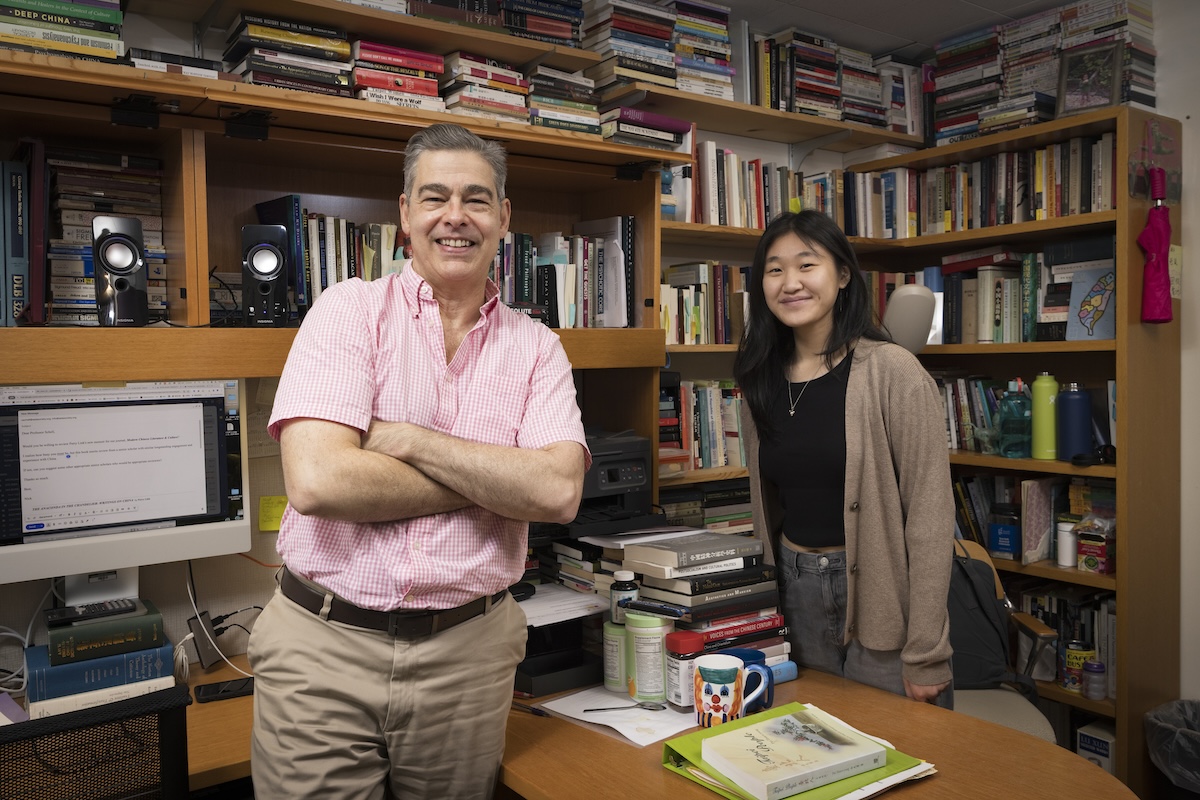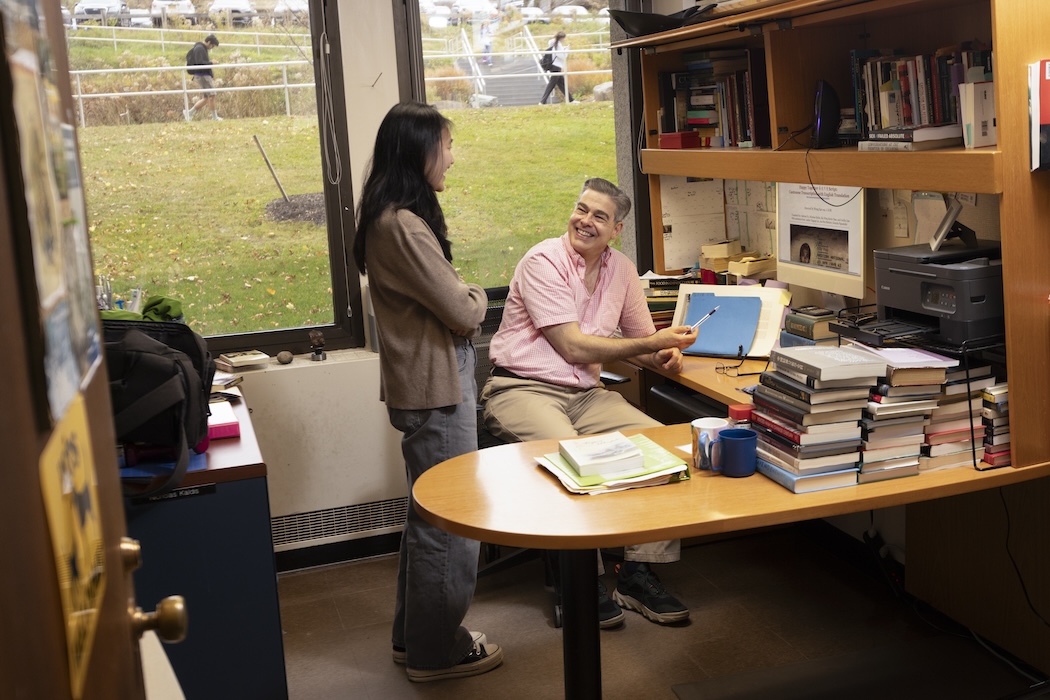Happy together: How a pair of Binghamton researchers translated a famous Chinese-language film
Chinese studies professor and student publish first complete script of "Happy Together"

In Spring 2024, Nick Kaldis, director of Chinese studies in the Department of Asian and Asian American Studies (DAAAS) at Binghamton University, and his student Sabrina Yu completed an ambitious — and first-of-its-kind — project.
“I’ve been teaching this film at Binghamton University for over 20 years,” Kaldis said. “It’s the first film in history by a Sinaphone, or Chinese language, director to win the prestigious Best Director award at the Cannes Film Festival — and there’s no script for it! This lack of an accurate script has marked an inexcusable gap in the resources available for this outstanding film and frustrated researchers and academics, not to mention lovers of Hong Kong cinema and Wong Kar-wai’s work.”
Happy Together’s two main characters, Ho Po-Wing and Lai Yiu-Fai, are a gay couple from Hong Kong living in Argentina. They have a history of being cruel to one another, and the film chronicles their spiraling relationship. The film is regarded as one of the best LGBTQ films in the New Queer Cinema movement; the availability of a complete and accurate script helps to sustain audience interest in Sinophone LGBTQ films and other forms of non-gender-binary-themed visual entertainment, which are increasingly censored in areas governed by the Chinese government.
The more Kaldis and Yu worked on this project, the more they realized just how important it was to get everything just right; they consulted and credited numerous experts in Cantonese and other languages featured in the film, added nearly 40 still shots and inserted hour-minute-second markers to locate scenes. They also included footnotes and explanatory text to supplement the film.
Eventually, they realized the final project deserved a wider audience. After peer review, it was published on The Modern Chinese Literature and Culture Resource Center, the leading website for scholarly resources on modern Chinese culture. Yu will complete her bachelor’s degree with a rare achievement — a publication credit in an international scholarly archive. Their script serves as an important reference for scholars in the fields of Hong Kong, Sinophone, Asian and Queer cinema.
“There are scripts claiming to be official, but when I was doing research, I would check carefully, and most of the time, things seemed a bit off,” Kaldis said. “I would consult Cantonese linguists and native speakers about the subtitling or online translations of the script, and they would invariably say, ‘No, it’s mistaken.’”
Yu, a senior at Binghamton pursuing a double major in graphic design and Chinese studies, says this is likely because the translators of previous versions took the Mandarin dialect as their standard when transcribing, making the subtitles and transcriptions a rough approximation into Mandarin of dialogue that is delivered mostly in Cantonese (the two dialects are mutually unintelligible). As a result, much of the film was literally “lost in translation.” Yu is sensitive to this distinction, since Mandarin is the standardized national language in mainland China, and the number of fluent Cantonese speakers is steadily decreasing.
“When I was a kid, my grandma on my mother’s side always took care of me, and she does not know English,” Yu said. “I grew up speaking Cantonese because of her, and I was interested in transcribing the film because it’s pretty much my mother tongue, and it’s a dialect that I now see as dying out. I thought working on the transcription would be fun, and that I could learn a lot about my heritage!”
For Yu, working on this project meant a lot of dedication — or stubbornness, if you ask her directly. The process, she says, is very repetitive, and she would often loop the same 10 seconds of dialogue from a scene over and over, at a significantly slowed speed.
“You can’t rely on the subtitles; it’s just what you hear and the emotion to go off of,” Yu said. “There was also a lot of me repeating the dialogue into my phone using Cantonese dictation, and then after that, I would see if what I said made sense using the words that I would use. Often, I would go to my mother and ask her if something was right or wrong. Then I would do it all again and again.”
Yu began learning Mandarin Chinese 101 at Binghamton during her sophomore year, which she used in the project. She says she is “happy to just be part of the project,” but Kaldis sees things a little differently. Although he’s been with the University for 23 years, this was his first time publishing collaboratively with an undergraduate student, and he described it as an incredible experience.
“This is the type of project I would normally expect to do with a fellow professor or an advanced graduate student,” he said. “Sabrina’s research focus and the rigor of what she does were extremely impressive. She dug into things that she didn’t understand and discovered the correct written characters for almost all the Cantonese words spoken in the film.”
When Kaldis came to Binghamton in 2001, there was not yet a standalone Chinese studies program; it was instead nested inside the now-defunct German, Russian and East Asian Languages and Literatures Department. He remembers feeling excited about the growth potential when he started teaching at Binghamton University. Even with that enthusiasm, he says now that he could not have imagined he’d be working with undergraduate students to create work that impacts the field of Chinese studies well beyond the reach of the Binghamton University campus.
“Our film script has a permanent online link at the most important academic resource in the world for modern Chinese culture,” Kaldis said. “Projects like this advertise Binghamton University’s Chinese Studies Program, Harpur College and the campus as a place where high-quality scholarship in Sinophone cinema is taking place. People can point to our campus on a map of global academic institutions and say, ‘This institution is generating high-quality and much-needed scholarly resources in the field of modern Chinese cultural studies.’”

